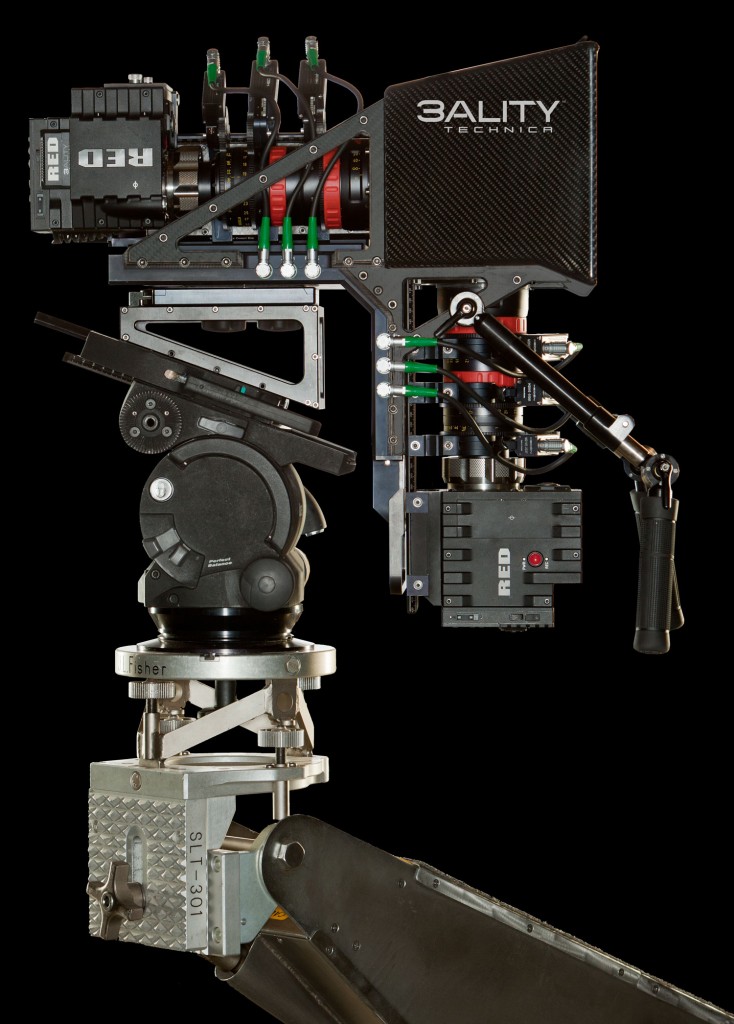 If you watched any of The Hobbit production videos* released in the year leading up to the release of An Unexpected Journey, you?ve likely seen the handiwork of Steve Schklair and his company 3ality Technica. If you?ve seen the film itself or any number of other 3D-shot films in the last few years then you?ve most certainly seen their work, as the team at 3ality Technica have been quietly empowering 3D productions with the latest rigs for some time now.
If you watched any of The Hobbit production videos* released in the year leading up to the release of An Unexpected Journey, you?ve likely seen the handiwork of Steve Schklair and his company 3ality Technica. If you?ve seen the film itself or any number of other 3D-shot films in the last few years then you?ve most certainly seen their work, as the team at 3ality Technica have been quietly empowering 3D productions with the latest rigs for some time now.
The goal at 3ality?Technica is to make shooting native 3D as efficient, cheap, and logistically feasible as shooting in 2D. They accomplish this by creating ever-lighter, stronger, versatile rigs in which to house 3D camera systems, as well as image processors that allow filmmakers to capture the best possible stereoscopic imagery and most confidently integrate frame depth into their storytelling. It?s true that many of you may not be the biggest fans of 3D, but this is a company working to drive lazy post-conversion out of studio mind?s, and ensure that filmmakers have enough control over the format to exploit its legitimate creative possibilities.
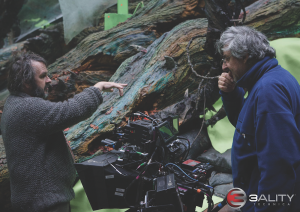 I had the fabulous opportunity to speak with Steve Schklair ?the CEO of 3ality Technica, and a man that has been working with 3D systems as long as anyone? about his company?s involvement with The Hobbit. Spoiler Alert: It was a lot.
I had the fabulous opportunity to speak with Steve Schklair ?the CEO of 3ality Technica, and a man that has been working with 3D systems as long as anyone? about his company?s involvement with The Hobbit. Spoiler Alert: It was a lot.
The company?s work has empowered filmmakers like Martin Scorsese, Baz Luhrmann, Bryan Singer, Ridley Scott, Gore Verbinski, Sam Raimi, and of course Peter Jackson to?transition?into 3D filmmaking?environments?without actually changing the way they make films. Steadicam, handheld, dolly, cranes? all the traditional workhorses of filmmaking remain available using these rigs, even as two cameras with two great big lenses have to work in concert together. This is largely accomplished with rigs that use mirrors to split the image between one forward-facing camera for one eye, and a second, under-mounted (?underslung?) camera for the other.
Here?s my interview with Mr. Schklair, conducted on the day of the release of The Hobbit. Note this is all about 3D and the equipment that goes into that, so we didn?t get into any High Frame Rate discussion. I?ve already tackled that topic pretty thoroughly elsewhere. I hope you enjoy!
Renn: Now that The Hobbit is out there and everybody is seeing it, I know a lot of people will be interested in a lot of the technology behind it. So, if you would, just kind of give me an introduction to your role at 3eality and your work with Jackson and other filmmakers.
Mr. Schklair: 3ality actually has kind of a single specific purpose; and that is 3D filmmaking. So, because The Hobbit was shot in 3D and it was shot with our technology, our involvement was to supply technology and training to Peter Jackson and his team prior to the start of Hobbit. You know, with everything they needed to make a 3D movie. That involvement, first of all, started with some testing because, obviously, Peter is going to test every vender in the market. But you know, at 3eality we?re able to promise something that other people promise, but, so far, I think we?re the only ones who actually deliver this, which is you can shoot a movie on a 2D schedule and that the 3D won?t slow you up; because of the technology we?ve put in place. So, after testing everything, Peter Jackson and his team did choose to work with us. And so, we delivered some equipment and they began their testing because they do a lot of 3D-testing before they shoot their movie.
Renn: Of course.
Mr. Schklair: And of course they came back the needs for lots and lots of modifications. You know, this was new equipment for us to deliver to the market. It?s never ? it had only gone out ? it was actually before Spiderman, even though Spiderman shot first. The test equipment went out to New Zealand before even Spiderman started, so being new equipment, filmmakers will want to put lots of modifications on it to make it something that meets their purposes better. So, we spent a fair amount of time working closely with Peter and his team on just refining the equipment, modifying the equipment, building custom pieces, and additional training for how to shoot 3D because it was a very long shoot ? well over a year.?This is common knowledge, but that?s way too long to keep Hollywood crew, so it was important that the New Zealand crew be well trained in the use of not just the equipment, but in 3D, and so that was really our role. It was really much more towards the beginning of the film. Once we started filming, there were few requests. Every once in a while, there?s a star parts request, but our involvement really was ninety-five percent at the beginning and before they started ? during prep.
Renn: Was there any additional challenge just due to the sheer scale of what they were doing? I know they were shooting with four dozen or so RED cameras and their indoor and outdoor shooting was such on a massive scale.
Mr. Schklair: If you cut the amount of RED camera in half, that tells you how many rigs they were using. And so, the challenge really was the scale to deliver that much equipment, and make sure everything worked, and of course, every time there?s an upgrade, because they?ve requested a change. I mean all the changes were great ideas and obviously to the benefit of the gear, so we?re happy to do it. But I mean we?re not changing one or two rigs, we?re changing a lot.
Or you?re not changing the software and the one image processor, you?re changing a lot of them. So, you know, the upgrades schedule was a little bit of a challenge just because there was so much equipment out there. Obviously, nothing that we can?t solve, but you know, in terms of other shows, whether you can send a technician to set for an hour or two and everything is upgraded and wonderful, it took a little longer on this because they were also still shooting. So, you don?t want to take down shooting equipment, so you just starting rotating in spares or units that weren?t being used at the moment. So, there?s a little bit of logistics involved.
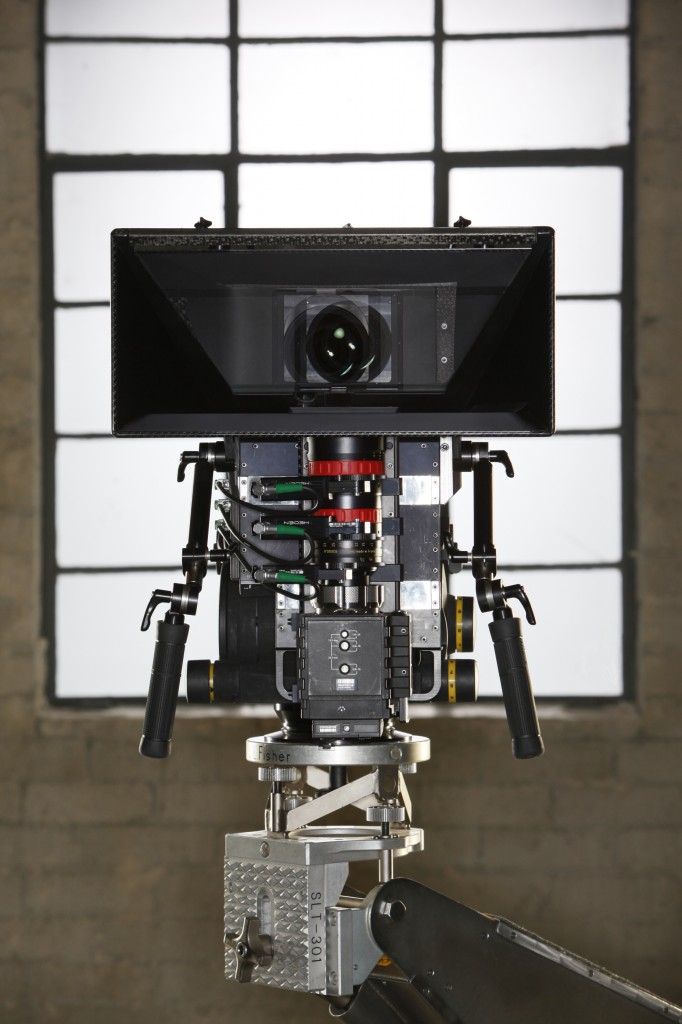 Renn: It seems like one of the ways that you guys try and put yourselves out ahead of, I guess, the competition or just generally improve the industry is by making these rigs lighter, and smaller, and more flexible for using existing grip and camera movement equipment. Tell me a little bit about that. Is that kind of your primary goal on that end?
Renn: It seems like one of the ways that you guys try and put yourselves out ahead of, I guess, the competition or just generally improve the industry is by making these rigs lighter, and smaller, and more flexible for using existing grip and camera movement equipment. Tell me a little bit about that. Is that kind of your primary goal on that end?
Mr. Schklair: Prior to starting this company, I had made a few 3D films. Mostly for the theme park industry. You know, when Digital Domain made Terminator 2 3D for Universal, I was Vice President there.?And we?d always shot film. Shooting film 3D is a very heavy rig; it?s big heavy equipment. And so, it limits the amount of shots you can do per day because of the complexity of the rigging. It?s bigger, heavier stuff. You know, it increases the crew size. Just to move the camera it took a couple of people; not just one person. So, I started this company with a goal that if 3D were to be a viable medium in digital television, it had to be small and lightweight just like existing broadcast equipment, and it had to be digital because you needed a signal immediately. You can?t, you know, broadcast anything on a film camera because you?ve got to go through the lab and processing.
Renn: So that philosophy brought you here.
Mr. Schklair: That was the goal when I started the company; was to make the equipment faster, smaller, and lighter. By making it smaller and lighter, it would be faster. And you know, everybody wants to shoot steadicam. There?s no way you could ever put those 3D film rigs. There were some custom pieces you could put on, but there was no way you could put general-purpose 3D rigs that relied on film cameras into a steadicam and shoot. So, the whole goal of the company, from the start, was to make it. We had a couple goals, and one was, eventually, we have to able to shoot 3D on the same schedule as a 2D film, or this will never be anything that works in mainstream Hollywood because lots can change in Hollywood, but schedules do not. And you know, at the beginning, in the year 2000/2001 or 2002, shooting 3D meant doubling your shooting schedule. Now, on a feature film, the shooting part is most expensive.
Renn: So naturally the area of most concern.
Mr. Schklair: Of course, unless it?s a heavy CGI picture. So, the idea of doubling the schedule just isn?t going to fly in mainstream Hollywood, so the goal was to make the equipment feel like professional equipment. In other words, not like a garage experiment that happened to capture 3D images, but it had to be rugged. It had to be durable. It had to be configurable in many different configurations depending on the environment and the conditions you?re shooting because people shoot movies all over the world in all kinds of conditions. So, that was our stated goal. Now, we knew the way to get there. I knew the way to get there would not be through making smaller and lighter rigs only, but through a lot of advanced image processing technology. In the past, shooting 3D meant you?d line up the cameras best you could, took you half a day, and you?d shoot a shot; you know you?re going to have to do a lot of realignment and fixing of that shot in post. And that was the accepted methodology for 3D. Okay, you spend a long time aligning; then you go to post and you fix everything to get even tighter. But that was going to fly in mainstream Hollywood and it certainly wasn?t going to fly in the world of television, where you don?t have time for post because you?re doing a live broadcast. It goes straight from the camera through the switcher to the air. So, most of our focus was developing software and algorithms ? really advanced image recognition tools ? that would automatically align cameras and keep them in alignment throughout the shot, throughout the day. Lenses are optical instruments, so no two lenses are identical. I mean you know, in general, a 21mm lens looks pretty much the same between all of them, but when you overlay those two pictures, they are never a pixel-for-pixel match because they?re optical instruments. And if you?re talking about microns in adjustment, that would throw off a couple pixels.
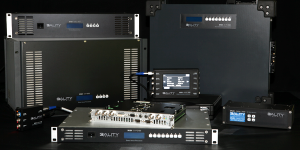
Renn: An intense challenge.
Mr. Schklair: You know, if you?re shooting a movie with a 21mm lens, you?re getting about the right image size. When you start overlaying images, it becomes hypercritical to be deadly accurate. Since lenses will never be able to do that ? no physical instrument can; that?s only possible in a virtual world -, the software became even more important because alignment was critical. You?re either going to align it right when you shoot or you?re going to spend a lot of time in post fixing things. And I?ve just never been a fan of fixing post, and I think it?s expensive. So, our goal with 3eality was to build a technology that made shooting 3D as close to showing 2D as possible.?As close to weight, size, durability, and the ease of use. You know, it couldn?t just be a small handful of 3D professional that shot everything like in the past. You know, if it was going to be a mainstream medium, then all film crews had to learn how to use it, which means you have to take the voodoo out of shooting 3D.
Renn: So, I?ve seen. It?s evidence by the production diaries that in just the few years since 3D has exploded, the rigs and imaging software have gotten extremely sophisticated very quickly. What do you feel like are the challenges that this industry still faces, where there are big advancements that can still happen?
Mr. Schklair: Lots of places. Film gets smaller and lighter. I mean a 3D rig is still bigger than a single camera.
Renn: Right. Will that happen in concert with camera manufacturers? I know you guys work with RED a lot.
Mr. Schklair: Possibly. There?s a number of ways to approach it and probably, I would say, all of them are being worked on. You know, there?s a huge difference, to me, in native shows. Hugo showed some of it and Life of Pi?showed some of it. Between shooting in 3D or post converting in 3D.
Renn: Certainly.
Mr. Schklair: So, to me, the biggest obstacle in the business right now is not the size of the equipment or the technology because that?s working very well, as evidenced by the diaries on Hobbit. It?s an education in the studio system that shooting 3D is not as difficult as they might be imaging. It doesn?t add too much to the budget. It doesn?t add anything to the schedule. I think the biggest obstacle right now is education. A lot of producers still have these fears that they?re going to way over budget and way over schedule if they shoot in 3D, so they?re choosing to convert the films because it?s more predictable. In fact, I think that does not lead to the best 3D. It leads to a veneer of depths over a 2D movie, which is great for eye candy, but it doesn?t make the story any better. Whereas shooting in 3D tends to make the story better. You know, if Luhrmann on Gatsby or Peter Jackson on Hobbit are looking at a 3D monitor when they?re setting up a shot, they?re going to stage it so that the 3D actually adds a story element to it.
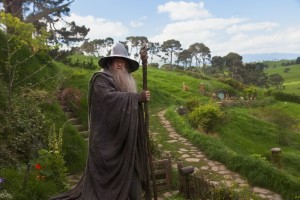 Renn: Well, I think audiences certainly tend to pick up on native 3D, whether they know it or not. It?s always a more satisfying experience.
Renn: Well, I think audiences certainly tend to pick up on native 3D, whether they know it or not. It?s always a more satisfying experience.
Mr. Schklair: Right. They might not articulate it, but they do pick up on it.
Renn: Absolutely. So, do you feel like this will be a way for studios to kind of push their movies out ahead of the home experience and keep the theatrical experience somewhat pure for a while? Or do you feel like this is a technology that?s going to democratize with any speed in the way that, say, the DSLR market has democratized standard filming?
Mr. Schklair: The US market is behind. There are parts of the world market where it already is democratized. If you go to London or anywhere in the UK, BSkyB is broadcasting 3D constantly. I mean you could watch multiple sporting events and multiple shows all week long on BSkyB as either recorded feeds or live feeds. You know, it?d be rare to be in the UK for a weekend and not find a live feed of some event in 3D. Our perspective is shaped because we?re here, in the US, and it hasn?t quite worked out that way. But in the UK, 3D is getting to be fairly mainstream on television.?And in China, the same. Although they?re just starting them, in fact, they?re moving very, very fast. And I think the movie business actually, in 3D, won?t exist if it doesn?t democratize.
Renn: Interesting perspective.
Mr. Schklair: You know, people were worried about sabotaging the movies when videotapes came out. And then, people were worried about sabotaging theatrical windows when DVDs came out. But it turned out they enhanced the revenue streams of the projects. And counting on the home revenue stream from release of a film on television or disc became part of the business case of actually making films. You know, when you?re putting together budgets and projections, you?re including both, theatrical release and home release. You know, a lot of movies wouldn?t be possible without the multi-release plans that are in place. You know, 3D shouldn?t be any different.
?
*
Source: http://www.chud.com/120770/interview-3d-rig-company-3ality-ceo-steve-schklair-the-hobbit-3d/
edwin jackson punksatony phil 2012 groundhog day groundhog phil pee wee herman ketamine ground hogs day 2012
No comments:
Post a Comment
Note: Only a member of this blog may post a comment.